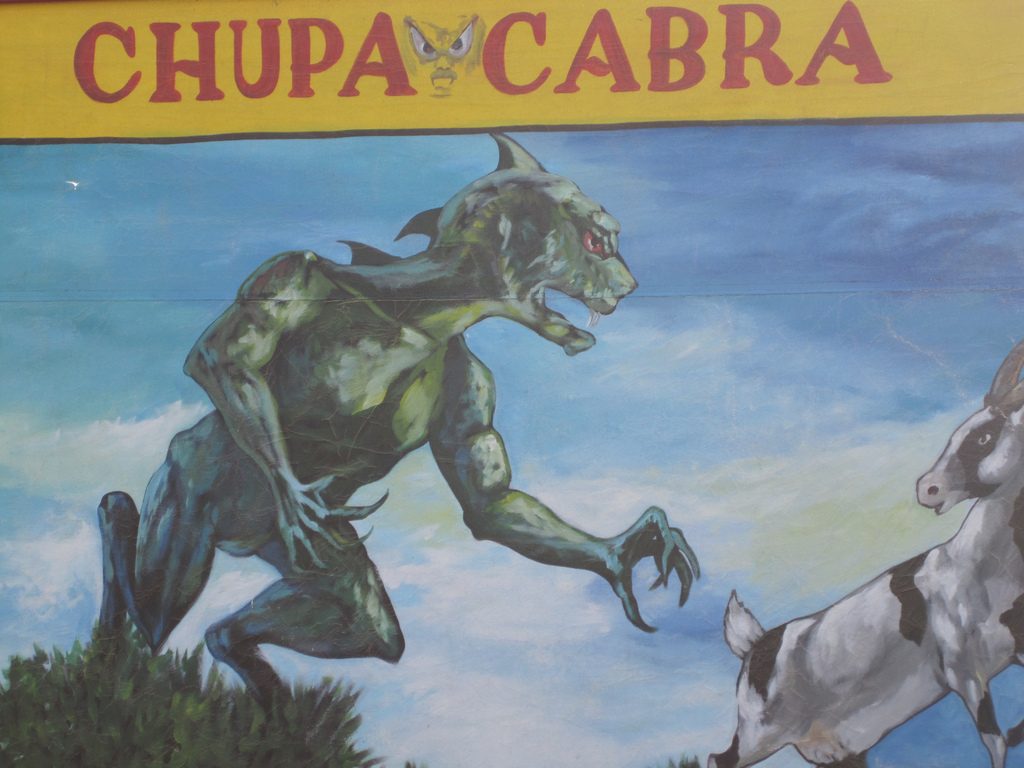Although the earliest reported sightings of the chupacabra were in the 1990s, the legendary creature has become deeply seated in the public consciousness. Those who believe that the chupacabra exists insist on its reality in spite of there being no photographical or scientific evidence of the species.1 Nonetheless, “flesh and blood chupacabras have supposedly been found as recently as June of 2017, making the monsters eminently more accessible for study than, say, the Loch Ness monster or Bigfoot.”2 The term chupacabra literally means goat sucker, referring to reports of this creature killing goats and drinking their blood. Therefore, the chupacabra has a symbolic link to the vampire. As interesting as the chupacabra might be, the sociological and psychological effects of these reports are equally fascinating. Since 1995, more than two hundred reports of chupacabra have surfaced, all from North America and most from Puerto Rico.3 These reports have led to negative effects in the affected communities, including widespread panic and unnecessary killing of wildlife.

The chupacabra has been spotted mainly in the United States and Mexico, and especially in Puerto Rico where the legend was originally born. As journalist David Moye points out, several residents of a small town in Texas have not just reported seeing the chupacabra, but also claim to have preserved chupacabra corpses.4 The scientific explanation most typically given for the chupacabra is not that it does not exist at all, but rather that it is simply a wild animal mistaken for the mythical creature. The most common explanation is that the chupacabra is a coyote with mange, which often appears “quite debilitated,” and which may prey on easy targets like livestock.5 Moye also states that some believe the chupacabra to be a type of raccoon. DNA analysis on a suspected corpse has revealed that in at least one case, the suspected chupacabra was nothing more than a “hybrid of a coyote on the maternal side and a Mexican wolf on the paternal side.”6 Nevertheless, not all sightings of the chupacabra are canine in appearance. Almost all the earliest sightings until 2000 were decidedly un-canine and described as “a bipedal creature that was three feet tall and covered in short gray hair, with spikes out of its back.”7

Although the chupacabra stories started to surface in the 1990s in Puerto Rico, Benjamin Radford, author of a book on the chupacabra, points out that there were earlier sightings throughout the twentieth century.8 The stories and the folklore surrounding the chupacabra have dramatically changed over the years, perhaps accounting in part for the shift in its appearance from an odd bipedal creature with spikes to one more canine in appearance and behavior.9 Bale describes the extent of the original reports of the chupacabra, noting that in 1994, residents of Canóvanas, Puerto Rico, had reported dozens of wildlife fatalities not limited to goats. Following the Puerto Rican reports, over two-thousand more farm animals were reported dead via a “grotesque creature about three feet tall, with membraned wings, a hunched back, large eyes, covered with either scales or quills.”10 Some reports also offer the chupacabra the additional sinister feature of “glowing red eyes.”11 Given its fearsome appearance and the trail of destruction left in its wake, it was no wonder that the affected communities started to panic. Whenever and wherever chupacabras had been spotted, residents of the community would go so far as to completely board up their residences, take up arms, and hire guards to protect their loved ones.12 In fact, some ranchers even started to sell off their herds to minimize their financial losses in anticipation of both drought and further chupacabra attacks. In California, a wave of chupacabra sightings led livestock owners and ranchers to declare “open season” on protected wildlife like mountain lions, leading to mandatory police controls of affected areas.13

The panic surrounding chupacabras became so widespread and potentially devastating to local communities that the governments of Mexico, Puerto Rico, and even the United States were forced to step in. As Bale points out, international press conferences ensued, including reports from “prominent biologists” who offered their theories about what the chupacabra could have been, plus another autopsy of a corpse conducted in Miami, which yielded results of the creature to be either a “puma or a dog.”14 Likewise, in 2007, biologists in Texas analyzed the DNA of a chupacabra and found it to be nothing more than a coyote.11 The biologists’ conclusions did little to assuage fears, as the analyses seemed inconclusive, lacking concrete and definitive evidence about what the creature might have really been and why so many continued to see something bipedal and vampiric. Even when the stories started to change, morphing the chupacabra into a canine creature, ranchers and farmers continued to cling to their claims and spread rumors.
The “confusion and contradiction” surrounding chupacabras comes from both sides of the debate, with reported sightings being too diverse and lacking in cohesive description to be seriously credible, and yet with scientific explanations also lacking substance.16 Given the diversity of reports, both in terms of their geographic locations, the description of the creature itself, and its effect on wildlife, it has been as difficult to debunk the existence of the chupacabra as to prove its existence. Unlike Bigfoot or the Loch Ness monster, there have actually been specimens that have been examined and tested, as well as thousands of animal victims of the chupacabra. Therefore, the legend of the chupacabra continues to proliferate and sink quickly into popular culture. Panic is less likely to be the reaction to a chupacabra reporting now, being replaced by a sense of pride in local customs and a mistrust of the government. In essence, the chupacabra plays perfectly to the tune of global conspiracy theorists.
The chupacabra is now known globally, even though its terrain remains geographically restricted, just as with the Loch Ness monster or any similar creature like the yeti. Mainstream news networks, from NBC and CNN to Univision and BBC, have all picked up on chupacabra stories, albeit reporting those stories in a clearly skeptical way.17 The television shows X Files and Scooby Doo both dedicated episodes to chupacabras, who also appeared on countless t-shirts and of course, Halloween costumes.18 A good number of these popular culture references are, of course, tongue-in-cheek, which has revealed an ancillary phenomenon: what Bale calls “a popular commentary on modernity,” similar to the Frankenstein legend.19
There is another important sociological and political effect from the chupacabras: the divide between the guardians of secularism and modernity versus those who believe in the importance of tradition and religion. Whereas it is easy for progressive, secular societies to dismiss the chupacabras out of hand, those who honor the legend, even for humorous purposes, acknowledge that folklore and storytelling play a significant role in human society. Folklore can link people together, offering the means by which to escape the harsher realities of war and climate change. There is also the fact that the people who have reported chupacabra sightings genuinely believe in the creature, and that it threatens their livestock and ways of life. When people from urban areas or communities in far away places start to wear a chupacabra t-shirt, it seems insulting to those who actually do believe that it exists and is a serious public safety concern. In fact, the people of Canóvanas, Puerto Rico, and small rural ranching communities in Mexico felt denigrated and “manipulated” by the mainstream media who painted them as “ignorant hicks,” and Bale also claims that the legend represents the means by which urban legends are used to expose or mirror angst in the public consciousness.20 Thus, chupacabras are at least an opportunity to study the symbolism and function of cryptozoology, as well as a means of studying the ways people manufacture supernatural stories for political or sociological purposes.

Interestingly, the chupacabra is never depicted as a creature that harms humans; it only targets livestock. This differentiates the chupacabras from vampires. Yet given that the chupacabra does inflict harm on human communities, it is a sinister symbol of terrorism and oppression. The stories occasionally run dry for several years, only to resurface with a vengeance when a farmer loses hundreds of goats or cattle at once and blames chupacabras. As Robert Jordan points out, too, the elusive platypus was once believed to be a fake creature relegated to cryptozoology as late as the eighteenth century.21 Therefore, the chupacabra may indeed exist. The question would then be: what does the chupacabra actually look like, if half the reports describe one thing and the other half something totally different?
Whether or not the chupacabra exists, the legends and stories are compelling in their own right. The stories are unique to North America, just as the Loch Ness monster is unique to Scotland. Furthermore, the descriptions of the chupacabra have changed significantly, showing how legends and stories can morph while still preserving their core essence and meaning. Finally, the chupacabra represents at once the reactions of rural people who are frequently painted as being backwards, as well as the condescending reactions of urban people who believe themselves to be superior, nonplussed by superstition or legend.
- Benjamin Radford, Tracking the chupacabra: the vampire beast in fact, fiction, and folklore (UNM Press, 2011), 133. ↵
- Robert Michael Jordan, “El Chupacabra: Icon of Resistance to US Imperialism,” (Master’s Thesis, University of Texas at Dallas, 2008), 4. ↵
- Robert Michael Jordan, “El Chupacabra: Icon of Resistance to US Imperialism,” (Master’s Thesis, University of Texas at Dallas, 2008), 7. ↵
- Moye David, “Living Chupacabra Captured By Texas Couple?” Huffington Post: Weird News, (April, 2014). ↵
- Robert Michael Jordan, “El Chupacabra: Icon of Resistance to US Imperialism,” (Master’s Thesis, University of Texas at Dallas, 2008), 5. ↵
- Moye David, “Living Chupacabra Captured By Texas Couple?” Huffington Post: Weird News, (April, 2014). ↵
- Robert Michael Jordan, “El Chupacabra: Icon of Resistance to US Imperialism,” (Master’s Thesis, University of Texas at Dallas, 2008), 4. ↵
- Benjamin Radford, Tracking the Chupacabra: The Vampire Beast in Fact, Fiction, and Folklore (Albuquerque: University of New Mexico Press, 2011), 43-44. ↵
- Jeffrey M. Bale, “Political paranoia v. political realism: on distinguishing between bogus conspiracy theories and genuine conspiratorial politics,” Patterns of Prejudice (Taylor & Francis Online), Volume 41, Issue 1 (February 1, 2007): 51. ↵
- Jeffrey M. Bale, “Political paranoia v. political realism: on distinguishing between bogus conspiracy theories and genuine conspiratorial politics,” Patterns of Prejudice (Taylor & Francis Online), Volume 41, Issue 1 (February 1, 2007): 48. ↵
- Funk & Wagnalls New World Encyclopedia, 2016, s.v. “Chupacabra.” ↵
- Jeffrey M. Bale, “Political paranoia v. political realism: on distinguishing between bogus conspiracy theories and genuine conspiratorial politics,” Patterns of Prejudice (Taylor & Francis Online), Volume 41, Issue 1 (February 1, 2007): 54. ↵
- Funk & Wagnalls New World Encyclopedia, 2016, s.v. “Chupacabra.” ↵
- Jeffrey M. Bale, “Political paranoia v. political realism: on distinguishing between bogus conspiracy theories and genuine conspiratorial politics,” Patterns of Prejudice (Taylor & Francis Online), Volume 41 Issue 1 (February 1, 2007): 57-58; J. Gabbatiss, “The truth about a strange blood-sucking monster,” BBC Earth (10 Nov, 2016). ↵
- Funk & Wagnalls New World Encyclopedia, 2016, s.v. “Chupacabra.” ↵
- Benjamin Radford, Tracking the Chupacabras (Albuquerque: University of New Mexico Press, 2011), 69. ↵
- J. Gabbatiss, “The truth about a strange blood-sucking monster,” BBC Earth, (10 Nov, 2016). ↵
- Jeffrey M. Bale, “Political paranoia v. political realism: on distinguishing between bogus conspiracy theories and genuine conspiratorial politics,” Patterns of Prejudice (Taylor & Francis Online), Volume 41, Issue 1 (February 1, 2007): 57. ↵
- Jeffrey M. Bale, “Political paranoia v. political realism: on distinguishing between bogus conspiracy theories and genuine conspiratorial politics,” Patterns of Prejudice (Taylor & Francis Online), Volume 41, Issue 1 (February 1, 2007): 60. ↵
- Jeffrey M. Bale, “Political paranoia v. political realism: on distinguishing between bogus conspiracy theories and genuine conspiratorial politics,” Patterns of Prejudice (Taylor & Francis Online), Volume 41, Issue 1 (February 1, 2007): 60, 292. ↵
- Robert Michael Jordan, “El Chupacabra: Icon of Resistance to US Imperialism,” (Master’s Thesis, University of Texas at Dallas, 2008), 3. ↵



64 comments
Johnanthony Hernandez
It’s interesting to see the lore behind the Chupacabra other than bad TV specials that only focused on the wake of its attacks. Growing up I, like many other Hispanic, had heard the stories from a young age. Many blame the attacks on local wildlife, saying that the Chupacabra is just a myth, but like you said much like the platypus that was thought to be a myth. It is possible that it may be a real animal that is doing this to livestock and that with new evidence we might finally now.
Didier Cadena
I’ve never really paid that much attention to the legend of the Chupacabra, so this article did a great job of informing me about the legend. I was not aware that legend exists in more places than just Mexico. It was also really informative to know about the medias influence on the legend and how the locals of Canóvanas felt offended that people make fun of the beast. The article does a great job of putting so much information and still making it an interesting read.
Maria Esquivel
This was a different version of the Chupacabra story for me. The story I always heard was that it loved to slurp human blood. My siblings and I thought it was funny and would always say “aye viene el Chupacabra’s por ti” but my Grandpa insisted that we should never play with something so serious. As I got older, I understood why he believed in this creature. I also found it interesting that the Chupacabra originated in Puerto Rico instead of Mexico. Very interesting read!
Anna Guaderrama
Honestly, growing up I knew about the Chupacabra but I always thought it was just like a Mexican or Hispanic thing. It’s nice to know that it’s become a worldwide known thing. I enjoyed reading the information on the Chupacabra showing the different versions and supposed forms that have been seen/talked about. Interestingly enough, I still don’t understand how it’s never been known as a human-killing creature but more of a creature that attacks mainly livestock.
Robert Rodriguez
Such an informative article! i didn’t know this legend had spread around the world, initially i thought it was just a Hispanic region thing. i found this article really interesting because both my grandmother and mother have claimed to have seen this unknown creature! if i recall correctly they told me it had wings and was about 3 feet tall, which slightly fits the description in the article! I’m surprised with how many places where the creature has “struck” that there is still no evidence proving if it actually exist, especially since governments joined on the search. very great article!
Amanda Cantu
Very well written article! No one ever told me about the Chupacabra but I remember reading about and watching movies too. It was great to actually read more about the urban legend. You gave me so much information and detail in your article so you did a great job. Whether people believe in them or not, its always interesting to learn about them.
Mario Sosa
The Chupacabra has always been an interesting subject, as their sightings range widely from looking like canine to having a small alien-looking appearance. Even more strange to me is why there have only started to be sightings of them in the 1990’s. If I have to give my two cents, I would say that the Chupacabra does exist – in a way that we humans cannot easily comprehend – but I believe that while there may have been some genuine sightings, there have also been many exaggerated/fake reports. Very nice article, great job!
Alejandra Mendez
Growing up in a Hispanic family, I definitely knew of the Chupacabra. I was told it was similar to a big and skinny dog’s shape. I have heard of many different stories on what the Chupacabra looks like and how people have spotted them in their backyards. Many of the stories I heard were from when I would go to Mexico when I was little and the farmers would say flocks of sheep would wake up with their necks bitten off and their blood completely drained. These stories definitely scared me into behaving.
Ryann Cervantes
I can relate a lot to this story since the Chupacabra is something that I grew up knowing and being told about. And I can’t help but feel a small amount of pride knowing that even though it only effects a certain region its fame is known worldwide. However, I did not know that there had been sightings in Puerto Rico or that even the Platypus was thought to have been a cryptid.
Clarissa Bustamante
This was such a great article! I have always known about the Chupacabras because growing up my family would always try to scare us with the story about them. The amount of detail you put into this article was great and how you included that it was not only a story but it was also a part of history. it is crazy how a story with no evidence could affect the lives of people and how a person wearing a chupacabra shirt can easily offend another person which how long this story has been around.